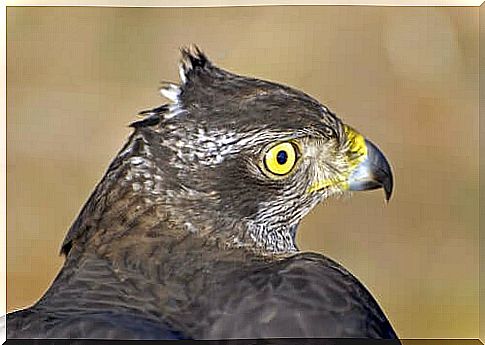Why Vision Is The Most Developed Sense In Birds Of Prey

Perhaps you’ve heard that a person has “eagle or falcon vision” if they don’t wear glasses and can see well at a distance. It turns out that one of the main virtues of birds of prey is precisely their vision, which allows them to detect prey from a great distance. Find out more about this topic in this article.
The bird’s eye view
Some can see in the dark, others several kilometers away… There is no doubt that vision is one of the most advanced senses of birds and that it has developed more than in other vertebrates.
Birds usually have very large eyes relative to their head size and do not have much movement within the eye socket. In addition to the typical covering eyelids, birds also have an additional, transparent, mobile membrane.
Birds have two types of light receptors: rods and cones. The former are better for night vision as they are light sensitive. Cones, in turn, can detect specific colors during the day.
Also, birds can perceive ultraviolet light and this is related to courting a potential mate. They still have plumage patterns that change color depending on the incidence of the sun, but that cannot be noticed by other species (including humans).

This feature gives them another advantage when it comes to getting food, as there are often prey that provide ‘glimpses’ noticeable to birds, even from a distance. Birds of prey can even identify rodent urine and feces because they reflect UV rays in some way.
Another interesting fact about bird vision is that they perceive movement, fast and slow, better than people and other animals. They even detect the sun’s movement across the sky! That way, they orient themselves during the flight.
In the case of birds of prey, which often spend a lot of time perched on a branch or rock, they keep their heads static to get a sure shot of what’s going on around them.
How is the view of birds of prey?
In addition to the characteristics indicated above (general for all birds), in the case of birds of prey, we must also emphasize that they are among the animals that have the best eyesight. They have a high density of receivers, as if they had binoculars included, with the aim of detecting their prey from a great distance.
It is noteworthy that the eyes of birds of prey, both diurnal and nocturnal, are located in front of the head. And that gives them a wider field of view, ranging from 35º to 50º.

In the case of nocturnal birds of prey, we must add the fact that they have a very flexible neck, which allows them to turn their head up to 300° and, in addition, their eyes are very clear in the dark.
The visual ability of birds of prey is popularly known, and this sharpness is due to several factors, including the size and shape of the eyes, which project a larger image onto the retina. Birds of prey are known to see up to eight times more than humans.
It is worth noting that eagles and hawks, among other birds of prey, have a greater number of receptors in the retina. This allows them to distinguish individual objects at great distances, such as a rodent trying to hide.
If the ophthalmologist tells you that “you have an eagle’s vision,” you may feel more than proud. These birds base part of their survival on developing their vision.









